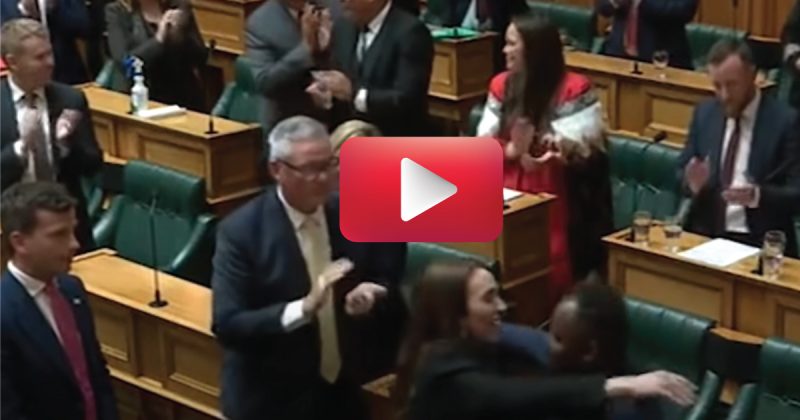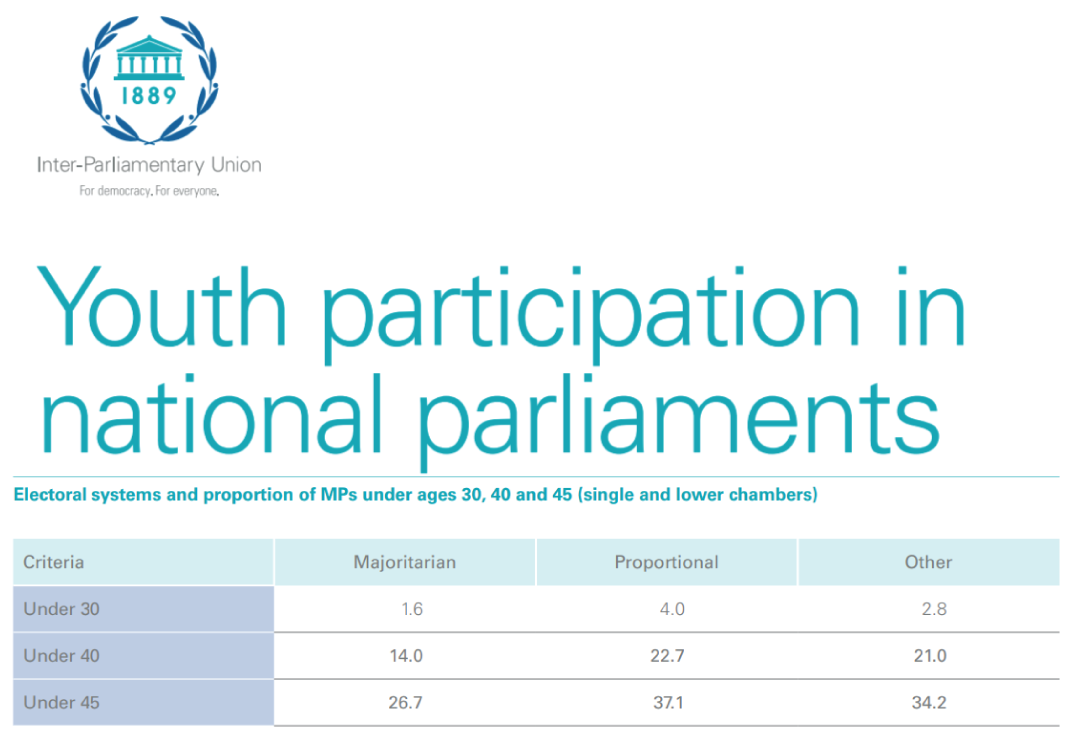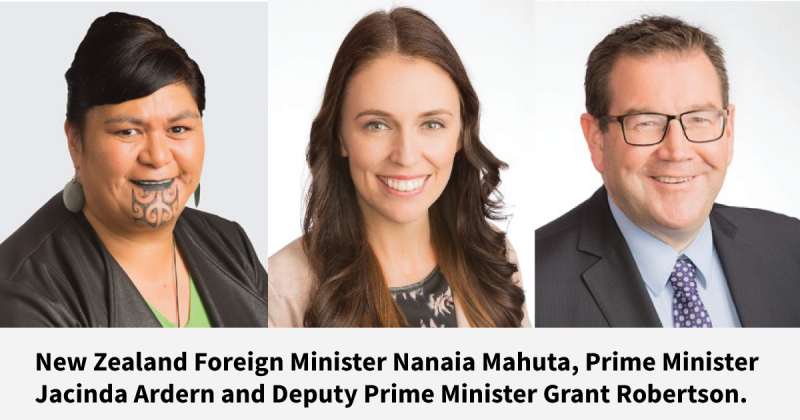
Photo: (Left) Former New Zealand Foreign Minister Nanaia Mahuta is Māori and wears a moko kauae, an ancient Māori tattoo. (Centre) Former Prime Minister Jacinda Arden was New Zealand’s youngest Prime Minister, and the third woman to hold the role. (Right) Former Deputy Prime Minister Grant Robertson is the first openly gay man to hold that role.
A Parliament more like us―naturally
In October, 2020, New Zealand elected a Parliament that news commentators around the world noted was extraordinary: a Parliament that reflected the people of New Zealand.
49% of the seats were held by women, the second highest among OECD countries at the national level.
11% of MPs wer LGBTQI – believed to be the highest in the world.
21% of the MPs were Māori, higher than their numbers in the population.
The oath of allegiance was sworn in 10 languages.
Hundreds of thousands of people watched the moving speech by new MP Ibrahim Omer about his journey from refugee to Member of Parliament.
Picture above: Former New Zealand Prime Minister Jacinda Ardern hugs newly elected MP Ibrahim Omer, following his speech about his journey from refugee to MP. Watch Ibrahim Omer’s moving speech.
Both Canada and New Zealand pride themselves on being multicultural societies. Yet the makeup of their Parliaments is a study in contrast.
Diversity in Canada’s Parliament
A few facts about who sits in our “House of Commons”:
- MPs tend to be older. The biggest group (41%) of MPs in 2019 were 59-64, with only 7% under the age of 35.
- MPs tend to be white. Ethnic minorities make up 27% of Canada’s population, but less than 18% of Parliamentarians in 2019.
- MPs are most likely to be male. 70% of our MPs in 2021 were men.
Although representation of women has increased slowly―by 10% since 1994―at the current rate it will be half a century or longer before gender balance is achieved. - Indigenous people make up 4.9% of Canada’s population, but less than 3% of our MPs in 2021.
- While 4% of the population identifies as LGBTQ2+, only 1.8% of MPs elected in 2019 did.
What does diversity have to do with proportional representation?
The purpose of proportional representation is to make every vote count.
In other words, when it comes to our political views, we get what we voted for. If 30% of the voters choose Party A, Party A will get roughly 30% of the seats.
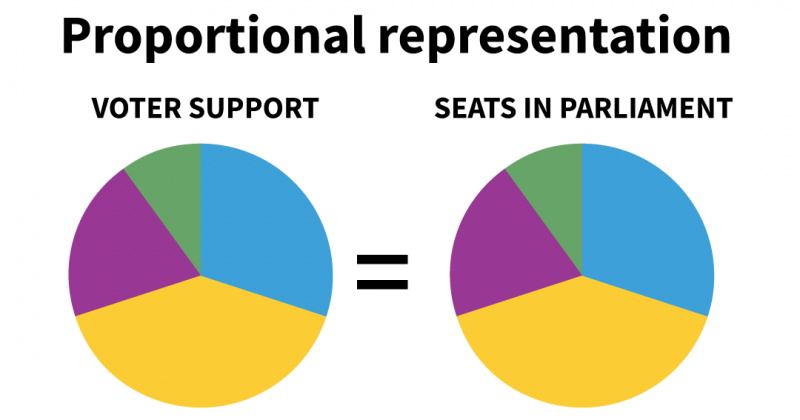
Governments are usually made up of two or three parties working together.
A lesser-known fact is that proportional representation can also deliver a Parliament that looks more like the people it represents. This can happen naturally.
With proportional representation for Canada, whether it’s Mixed Member Proportional (MMP) or Single Transferable Vote (PR-STV), there will be more than one candidate from the same party on your ballot.
It boils down to this: more voter choice.
So you can pick the best candidates for the job!
When parties must run more than one candidate on your ballot, people who are currently shut out of party nomination races can get in the race, instead of those spots being locked up by long-time incumbents.
Parties also do not want to look bad. When they only put up one candidate in each riding—in a winner-take-all system—their overall lack of diversity is not so obvious.
When they must offer voters more than one candidate on the ballot, they will want their candidates to reflect the communities they want to represent.
As the ACE Electoral Knowledge Network explains, proportional representation gives parties a natural incentive to offer more diverse choices:
“There are many ways to enhance the representation of minorities and communal groups. Again, electoral systems which use reasonably large district magnitudes encourage parties to nominate candidates from minorities on the grounds that balanced tickets will increase their electoral chances.”
A study of PR in Latvia shows that is exactly what happens.
How does proportional representation lead to more diverse Parliaments around the world?
Proportional Representation and Diversity Around the World: Women in Parliament
The most studied area of electoral systems and diversity by far is female representation.
The relationship between voting and women in legislatures has been studied for decades and the verdict is unanimous: on average, countries with proportional representation have more women in their legislatures.
Arend Lijphart, in his ground-breaking work “Patterns of Democracy”, looked at 36 countries over 25 years. Lijphart found representation of women was 8 percentage points higher in countries with PR systems.
The 2018 Inter-Parliamentary Union Report on Women in Parliament concludes:
“As in previous IPU reports, the 2018 election results confirm the long-standing observation that parliamentary chambers elected via proportional representation (PR) or mixed electoral systems tend to elect more women (26.5%) than those governed by first-past-the-post, or majoritarian, electoral systems (20%).”
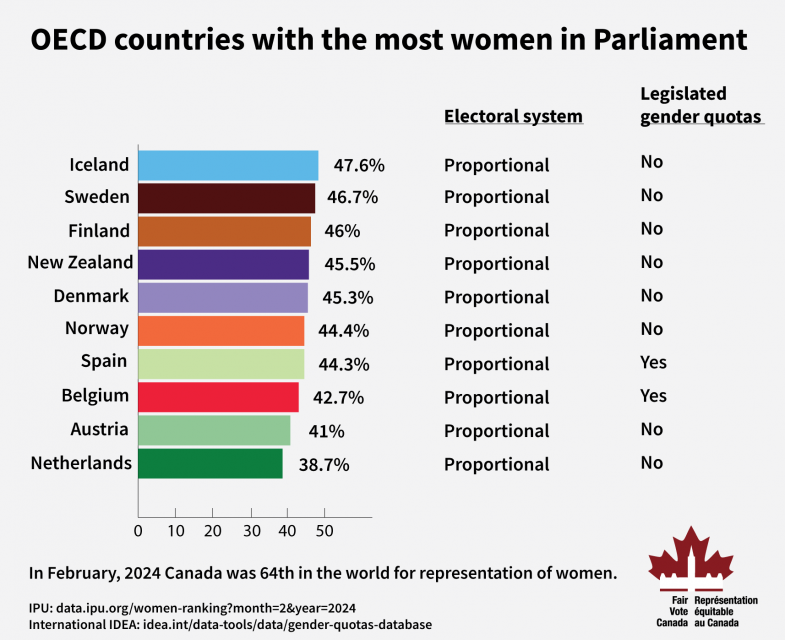
Representation of Women in Australia: A Lesson In Contrast
A striking example of the difference between the results of a proportional representation system and a winner-take-all system can be found in Australia.
In Australia, the Lower House is elected by a winner-take-all ranked ballot system (Alternative Vote).
The Upper House is elected by a proportional ranked ballot system (Single Transferable Vote).
Same country, same voters, often the same day, but very different results.
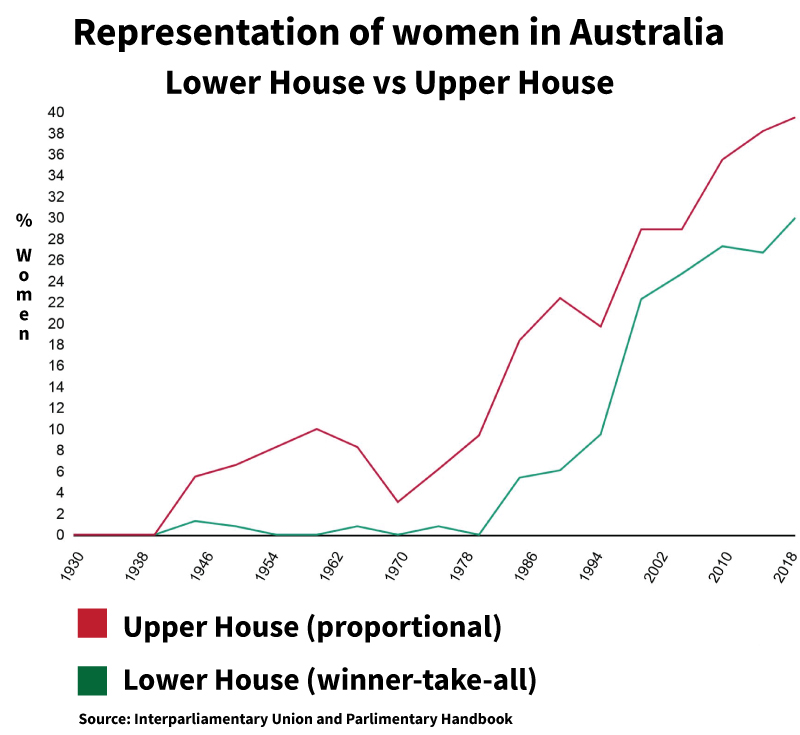
A more recent chart shows the discrepancy between women in elected in the Lower House (winner-take-all) and the Upper House (proportional) continues to grow.
In 2021, the percentage of women in the Lower House (winner-take-all) was 31.1%, compared to the Upper House (proportional) at 51.3%.
Australia ranks 57th in the world for female representation, practically tied with Canada, which ranks at number 59.
Australia’s states and territories provide another striking example of the difference proportional representation can make, when voters have more choice.
Tasmania and Australian Capital Territory (ACT) both elect their Lower Houses by proportional representation (Single Transferable Vote).
Australian Capital Territory (2016) and then Tasmania (2018) recently elected majority female legislatures.
Australian Capital Territories’ Parliamentary website notes:
“It was the first time in Australian history that a majority of women had been elected to a parliament and one of the first jurisdictions in the world to have done so.”
(Only Rwanda and Bolivia had succeeded before―both with the use of legislated quotas).
This outcome was repeated in ACT’s 2020 election, when 56% of elected MPs were women.
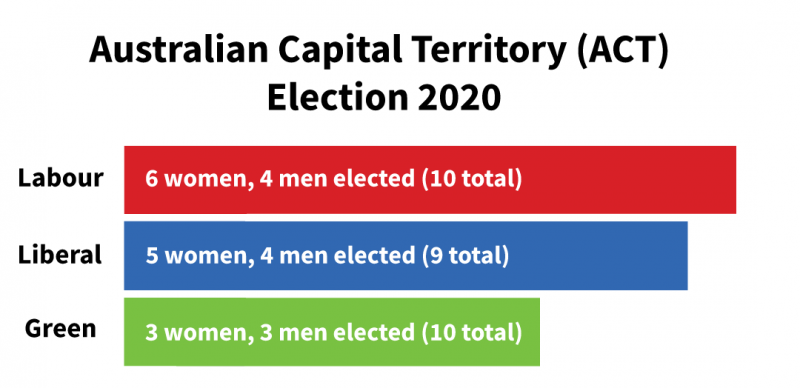
The ACT Parliamentary website goes on to explain how proportional representation, (PR-STV, which they call “Hare-Clark”) allowed voters to elect more women, naturally:
“The Hare-Clark system of proportional representation gives voters a substantial choice at the ballot box not only between candidates representing particular political parties but also between candidates within political parties. This choice can promote a more accurate reflection of the community in the composition of the Assembly.
A candidate in a single member electorate cannot personally reflect the diversity of their electorate.
Multi-member electorates can better reflect that diversity. More women get elected where voters are able to have direct input into the choice of candidate with their preferred political party.”
Female civil society leaders commented on the significance of more women to the political culture in Tasmania:
“What happens when you’ve got successful women is you then have role models that younger women can look at and aspire to but you also get a culture change.
“The whole issue of being in a very toxic, male-dominated bear pit, as they call it in New South Wales, is no longer an issue.
Obviously the public are at a point where they want to have female representatives and you want the balance, 52 percent is pretty good, you don’t want too many more women in one sense because you also want to have that male balance and perspective as well.”
Indigenous Representation in Australia’s Upper and Lower House
It’s not just representation of women where proportional representation can make a difference.
Since 1971, the Australian Upper House (elected with proportional representation) has elected five times more Indigenous representatives than their Lower House (elected with winner-take-all voting).
In the Upper House, Indigenous Peoples occupy 3.95% of the seats, slightly higher than their numbers in the population.
Yet in the Australian Lower House, Indigenous People have only 1.3% of the seats.
Representation of Youth in Parliaments Around the World
Many Canadians are concerned about the disengagement of youth from traditional politics. One way to empower youth is with an electoral system that gives more of them a seat—role models—in Parliament and at the decision-making table.
The Inter-Parliamentary Union (IPU) produces regular reports on youth representation in legislatures around the world. In 2022, Canada ranked 69th in the world for the representation of youth 30 and under in national Parliaments.
The IPU identify proportional representation as a key factor to increasing the number of youths elected. Their 2018 report concludes:
“Electoral systems affect patterns of political representation by creating distinct incentives for the nomination of candidates. PR systems often prompt political parties to balance their lists with candidates from a variety of backgrounds.
In contrast, majoritarian or plurality-based systems focus attention on individual candidates, such that party elites tend to nominate candidates like those already in office: overwhelmingly male and middle-aged.
Based on analysis of the 202 chambers … for each of the categories, the share of young MPs is significantly higher among chambers with PR/mixed systems.”
The IPU’s 2021 report on youth representation shows twice as many MPs under 30 in Parliaments elected by proportional representation:
When diversity in legislatures becomes the norm
New Zealand’s success in electing the most diverse Parliament in the world is a natural outcome of a voting system that gives voters real choice, and values every voice at the ballot box.
Jennifer Curtin, professor of politics and director of the Public Policy Institute attributes New Zealand’s diverse Parliament to the adoption of Mixed Member Proportional Representation in 1996:
“We’ve seen this incremental change in what our representatives look like, and the groups that they come from. We have been moving towards this moment.”
Research shows the proportion of MPs with a European background has decreased steadily over time, from 85% in 1996 to 68.6% in 2014.
While some ethnic groups, such as Asian people, remain under-represented, the improvement since the introduction of MMP has been massive.
At New Zealand’s 2020 swearing in ceremony, Prime Minister Jacinda Ardern commented on how far New Zealand has come:
“I think one of the amazing things about New Zealand is that we are often in a space now where all of these questions (about diversity) often become secondary,” she said. “The representation is there. And that is not the first consideration.”
As New Zealand MP Ibrahim Omer commented to his caucus in his maiden speech:
“I’m proud to be with a group that looks much like New Zealand.”
The same Australian Capital Territory election by proportional representation (PR-STV) that produced the second consecutive female majority legislature also elected Andrew Barr as Chief Minister, the first openly gay head of state or territory in Australia. A picture of Barr kissing his husband on election night was widely shared.
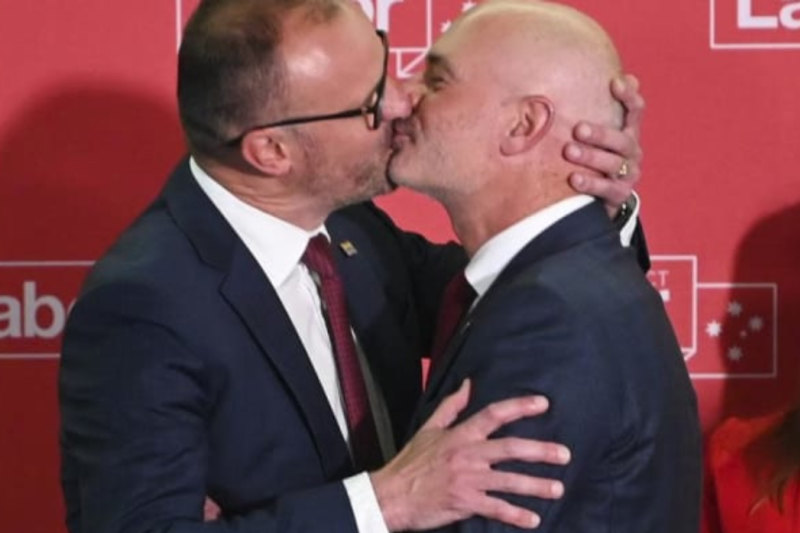
Asked about that moment, Barr told the Sydney Morning Herald:
“Yes, it was a significant moment. It’s gone a bit viral in the gay press around the world and I’ve seen it on social media as well. But the most brilliant thing about it was how unremarkable it was in Canberra. That, to me, is the biggest sign of progress.”
References
ACE Electoral Knowledge Network (2021). Representation of Minorities.
https://aceproject.org/ace-en/topics/es/esd/esd06/esd06b
Barker, Fiona and Coffe, Hilde. ́Representing Diversity in Mixed Electoral
Systems: The Case of New Zealand. Parliamentary Affairs (2018) 71, 603–632 doi:10.1093/pa/gsx073 Advance Access Publication 28 December 2017
Bloom, Stephen and Thames, Fran (2021). Nomination and list placement of ethnic minorities under open-list proportional rules: The centrality of ethnopolitical context. Electoral Studies, Volume 73, December 2021. https://www.sciencedirect.com/science/article/abs/pii/S0261379421001049
Gobbett, Hannah. Indigenous Parliamentarians, federal and state: a quick guide.(2017). Parliament of Australia. https://www.aph.gov.au/About_Parliament/Parliamentary_Departments/Parliamentary_Library/pubs/rp/rp1718/Quick_Guides/IndigenousParliamentarians
Green, Anthony (2020). Australian Capital Territory Election 2020 Results. ABC News. https://www.abc.net.au/news/elections/act/2020/results
Hunt, Ellen (2021). The world’s most inclusive Parliament still faces battle for change. The Guardian.https://www.theguardian.com/world/2021/feb/08/diversity-dilemma-worlds-most-inclusive-parliament-still-faces-battle-for-change-new-zealand
Ibrahim, Omer (202). Full speech. Ibrahim Omer recounts harrowing journey from war refugee to MP. https://www.youtube.com/watch?v=aYNdvKXpH4E
Inter-Parliamentary Union (2018). Women in parliament in 2018: the year in review. https://www.ipu.org/resources/publications/reports/2019-03/women-in-parliament-in-2018-year-in-review
Inter-Parliamentary Union (2018). Youth participation in national parliaments: 2018. https://www.ipu.org/resources/publications/reports/2018-12/youth-participation-in-national-parliaments-2018
IPU Parline. Monthly ranking of women in national parliaments. https://data.ipu.org/women-ranking?month=10&year=2021
Law, Benjamin (2020). Andrew Barr: ‘There’s so much hate and anger in the world, I don’t want to be a part of that’. Sydney Morning Herald. https://www.smh.com.au/politics/act/andrew-barr-there-s-so-much-hate-and-anger-in-the-world-i-don-t-want-to-be-a-part-of-that-20201013-p564qv.html
Legislative Assembly for the Australian Capital Territory (2018). You can’t be what you can’t see—Women in the Legislative Assembly for the Australian Capital Territory. https://www.parliament.act.gov.au/files/publications/articles-and-papers/you-cant-be-what-you-cant-see-women-in-the-legislative-assembly-for-the-australian-capital-territory
Lijphart, Arend (2012). Patterns of Democracy: Government Forms and Performance in 36 Countries. https://e-edu.nbu.bg/pluginfile.php/830138/mod_resource/content/1/Lijphart%2C%20A.%20Patterns%20of%20Democracy%20-%20Government%20Forms%20and%20Performance%20in%20Thirty-Six%20Countries%20%282012%29.pdf
Lim, Joslon and Gibson, Victoria (2019). Gender, minorities, parenthood: Here’s how the next Parliament compares to Canada today. iPolitics, https://ipolitics.ca/2019/10/24/gender-minorities-parenthood-heres-how-the-next-parliament-compares-to-canada-today/
Martin, John. ‘Parliament – Impact of MMP’, Te Ara – the Encyclopedia of New Zealand, http://www.TeAra.govt.nz/en/graph/47382/ethnic-diversity-of-mps
Mao, Frances (2019). 2019 election: Why politics is toxic for Australia’s women, BBC. https://www.bbc.com/news/world-australia-48197145
McIntyre, Damian (2018). Tasmania leading the way on female representation in Parliament. ABC News. https://www.abc.net.au/news/2018-03-16/tasmania-leading-the-way-on-female-representation-in-parliament/9553146
Neufeld, Mark (2021). What Canada’s 10 indigenous MPs can do for First Nations https://toronto.citynews.ca/2021/09/21/canadas-indigenous-first-nations-communities/
Ouellet, Valérie, Shiab, Naël and Gilchrist, Sylvène. White men make up a third of Canada’s population but a majority of MPs — here’s why. Radio-Canada, August 2021. https://ici.radio-canada.ca/info/2021/elections-federales/minorites-visibles-diversite-autochtones-racises-candidats-politique/en
Perry, Nick (2020). New Zealand’s new deputy leader first gay man to hold the role. AP News. https://apnews.com/article/cabinets-grant-robertson-new-zealand-c840239beabda3fd6f3fbdd81fd5ea4f
Statcan (2021). A statistical portrait of Canada’s diverse LGBTQ2+ communities. https://www150.statcan.gc.ca/n1/daily-quotidien/210615/dq210615a-eng.htm
Vaisey-Taylor, Nick and Carleton, Audrey (2019). Federal election 2019: This is what the House of Commons will look like. Maclean’s. https://www.macleans.ca/politics/election-2019-this-is-what-the-house-of-commons-will-look-like/

